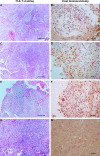Assessment of the association of OCT3/4 with GLUT1 and CD105 in oral squamous cell carcinoma using dual immunohistochemistry
- PMID: 35854304
- PMCID: PMC9297621
- DOI: 10.1186/s12903-022-02332-w
Assessment of the association of OCT3/4 with GLUT1 and CD105 in oral squamous cell carcinoma using dual immunohistochemistry
Abstract
Background: Oral squamous cell carcinoma (OSCC) is the most common cancer affecting the oral and maxillofacial region. This study aimed to investigate the role of cancer stem cells (CSCs) in angiogenesis and hypoxic response in OSCC.
Methods: This retrospective observational study evaluated 56 cases of OSCC using dual immunohistochemistry. Octamer-binding transcription factor 3/4 (OCT3/4) marker was used to evaluate CSC activity. Glucose transporter 1 (GLUT1) marker was used to evaluate the hypoxic response and angiogenesis, while endoglin (CD105) was used to evaluate the late stage of angiogenesis and blood vessel formation.
Results: Co-expression of OCT3/4 and GLUT1 was noted in 11 of 12 patients with grade III OSCC. However, we did not observe co-expression of these markers in 13 of 22 patients with grade I OSCC. Although we observed a significant correlation between co-expression of GLUT1 and OCT3/4 and tumor grade, there was no significant correlation between co-expression of OCT3/4 and CD105 and different grades of OSCC.
Conclusions: CSCs could play important roles in the initial stages of hypoxic response and angiogenesis. Our result reported that in higher grades of OSCC, GLUT1 as a first response to hypoxic situations might be a result of CSCs. Further studies are required to discover other biomarkers, their roles, and associated pathways of CSCs in OSCC.
Keywords: Angiogenesis; Cancer stem cell; Dual immunohistochemistry; GLUT1; OCT3/4; Squamous cell carcinoma.
© 2022. The Author(s).
Conflict of interest statement
The authors have no conflict of interests to declare.
Figures




Similar articles
-
Expression of Oct3/4 and Nanog in the head and neck squamous carcinoma cells and its clinical implications for delayed neck metastasis in stage I/II oral tongue squamous cell carcinoma.BMC Cancer. 2015 Oct 19;15:730. doi: 10.1186/s12885-015-1732-9. BMC Cancer. 2015. PMID: 26483189 Free PMC article.
-
Microvascular density and tumor budding in oral squamous cell carcinoma.Med Oral Patol Oral Cir Bucal. 2023 Mar 1;28(2):e174-e182. doi: 10.4317/medoral.25640. Med Oral Patol Oral Cir Bucal. 2023. PMID: 36565216 Free PMC article.
-
Immunoexpression profile of hypoxia-inducible factor (HIF) targets in potentially malignant and malignant oral lesions: a pilot study.J Appl Oral Sci. 2023 May 15;31:e20220461. doi: 10.1590/1678-7757-2022-0461. eCollection 2023. J Appl Oral Sci. 2023. PMID: 37194791 Free PMC article.
-
The role of novel prognostic markers PROX1 and FOXC2 in carcinogenesis of oral squamous cell carcinoma.J Exp Ther Oncol. 2018 May;12(3):171-184. J Exp Ther Oncol. 2018. PMID: 29790306 Review.
-
miRNA Associated With Glucose Transporters in Oral Squamous Cell Carcinoma: A Systematic Review.Cureus. 2023 Sep 27;15(9):e46057. doi: 10.7759/cureus.46057. eCollection 2023 Sep. Cureus. 2023. PMID: 37900425 Free PMC article. Review.
Cited by
-
The Possibility of Plasma Membrane Transporters as Drug Targets in Oral Cancers.Int J Mol Sci. 2025 May 1;26(9):4310. doi: 10.3390/ijms26094310. Int J Mol Sci. 2025. PMID: 40362545 Free PMC article. Review.
-
Panoramic view of key cross-talks underpinning the oral squamous cell carcinoma stemness - unearthing the future opportunities.Front Oncol. 2023 Dec 19;13:1247399. doi: 10.3389/fonc.2023.1247399. eCollection 2023. Front Oncol. 2023. PMID: 38170015 Free PMC article. Review.
References
-
- Feller L, Lemmer J. Oral squamous cell carcinoma: epidemiology, clinical presentation and treatment. J Cancer Ther. 2012;03:263–268. doi: 10.4236/jct.2012.34037. - DOI
Publication types
MeSH terms
Substances
LinkOut - more resources
Full Text Sources
Medical
Miscellaneous

